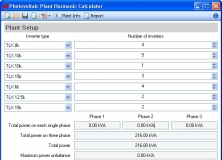v6.4 [Jan 19, 2016]
May include unspecified updates, enhancements, or bug fixes.
v6.0 [Feb 25, 2013]
Financial balance with net-metering: error when defining consumption tariff
Shadings acc. to module strings: little error in some rare cases
v6.0 [Feb 28, 2013]
Meteonorm Inside
- Direct search of any location on the earth, using the well-known GoogleMap tool.
- Immediately get the monthly meteo values for any site, using the interpolating possibilities of Meteonorm 6.1.
- Synthetic generation of hourly values uses now the Meteonorm algorithm, improved by respect to the old PVsyst algorithm.
- Included import of meteo values from new databases, for example SolarAnywhere (SUNY model) satellite recent data covering the whole USA.
- Transposition model on tilted planes: Perez model now proposed as default instead of Hay, leqading to an increase of 0 - 2% yearly sum according to climate and orientation.
Project management and simulation process
- Project management Dashboard, with direct access to all parameters, simulation and results in a single dialog.
- Improved project management: copy, saving, transfers of calculation versions from projects to projects, copy of full projects.
- Losses: new organization of the loss diagram. New losses like LID, System unavailability, Inverter auxiliary or night consumption, Light-soaking gains for CIS.
- Batch mode for parametric studies: allowing to vary parameters in an EXCEL document, and get chosen simulation results of multiple runs as a table.
Improved shading calculations
- Direct shading factor calculation during the simulation (avoiding the interpolation uncertainties in the shading factor table).
- Optimization of the calculation of the shading factor, allowing calculations of big PV plants without limitation to some hundredth of trows or trackers (factor of 10 on the speed).
- Plants following the terrain, imported by Helios3D: analysis of the spread of orientations, management of the orientation average.
Detailed electrical shading losses
- Refinement of the "module layout" part, which allows to define the position of each PV module on the areas ("tables") defined in the 3D shading tool.
- Modules arrangement in portrait or landscape, sub-modules in length or width within each module.
- Attribution of each module to a given string and inverter.
- Detailed calculation of the I/V characteristics under partial shadings in each Inverter input, either as pedagogic plot, and during the simulation for the determination of the "electrical losses" due to the shading mismatch.
PV modules
- Tools for specifiying low-light performances, and adjustment of the Rserie parameter accordingly. Low-light efficiencies may be included in the parameters in the database.
- Modification of the default values for Gamma, when Rseries is not explicitely defined by the manufacturer, giving significant higher yields of 2-3%.
- Import of a measured I/V curve for the establishment of the model's parameters.
- Sandia model implementation, and comparison with the one-diode model.
- parameters: IAM profile in the module's parameters, Vmax(UL) for use in US, full tolerance definition, LID for crystalline and Light-soaking for CIS.
- Easy choice of modules by manufacturers.
Inverters
- Multi-MPPT with unbalanced inputs - define main and secondary inputs.
- Additional parameters: transformer specification, CEC average efficiency for US, auxiliary and night losses.
- Easy choice of inverters by manufacturers.
Program Installation and Background
- file organization, with clear distinction between internal database and custom files.
- data management, easy copy of the the full custom data set from previous installations, no problems of Administration rights anymore.
- Certified installing package by PVsyst SA, registered in Windows.
- Easy automatic updates.
- protection management.
v5.5 [Sep 23, 2011]
1. Read Meteonorm: problems (monthly irrad=0) near polar circle
2. Inverter 3-voltages efficiency: OK if 2 voltages identical
3. Inverter and PVModule export to EXCEL:
decimal dot or comma acc. to international settings
4. Monthly tables: errors in units for Yr and Ya
5. Report: corrections (economics) and improvements (shadings)

It enables you to share simulation knowledge with your extended design team

It helps students build a practical knowledge of light and electricity.

It calculates the harmonics caused by a PV Plant at common point of coupling.